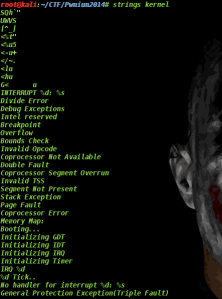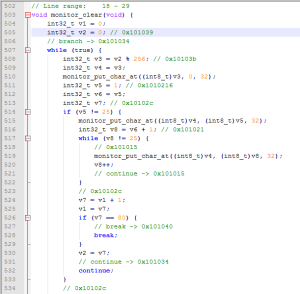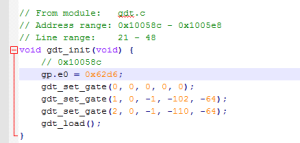by Shubham Bansal [iN3O@SegFault]
This year’s CSAW CTF [2014] was fun, especially Pwning and Reversing sections.
Here,I am going to explain my solution of — Aerosol Can — Reverse 500 — although I didn’t do it in time and i haven’t found any writeup for this problem online so here we go…
1. Start
We are given a 32-bit executable.
04:48 AM iN3O:Aerosol_Can-500>file aerosol_can
aerosol_can: ELF 32-bit LSB executable, Intel 80386, version 1 (SYSV), dynamically linked (uses shared libs), for GNU/Linux 2.6.24, BuildID[sha1]=0x366b4f02c3b5f4196a54512332f79396bc20ef2e, stripped
2. Understand
Lets open this in IDA.

In IDA, we see the main_func function which checks for the number of arguments passed to the binary and prints “Must have at least one argument\n” string if its less then 2 otherwise it passes the second argument to the function call starter(0x8053460) which checks for the correctness of the 2nd argument we passed, which in this case, is our flag string. If we passed the correct flag then function starter returns the 0 otherwise any other negative value.
lets go inside starter function…
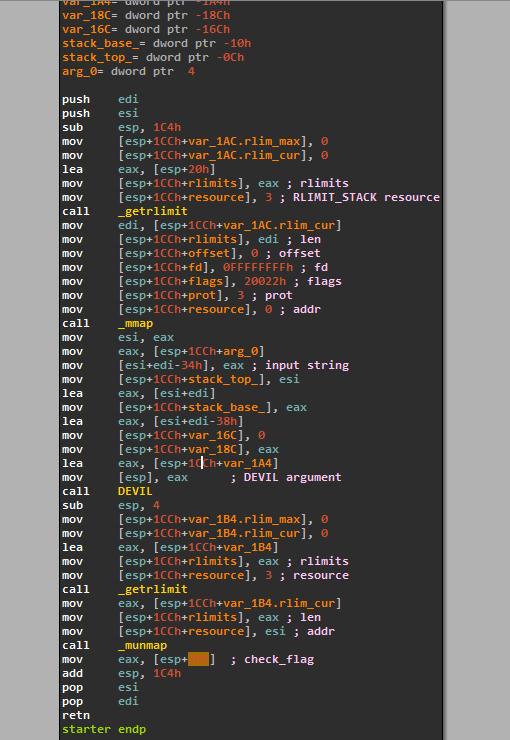
What this function does is :
- Calls getrlimit function to get the stack limit(size) for the program.
- Calls mmap function to map virtual stack of the same size as above.(this will later be used extensively)
- Call function DEVIL(0x8048660) to do some processing on our input string.
- Again Call getrlimit function to get the stack limit(size) of the program.
- Call munmap to unmap the previously mapped stack.
3. Obfuscation
DEVIL function is passed some address(esp+0x11c-0x1A4) of the original stack, but before that it puts an address(base address of new stack – 0x38) at [esp+0x11c-0x18C] which is at an offset 0x18 of the address which is passed in DEVIL function.It also puts the address of the input string at(base address of new stack – 0x34) which is just below the address we put at [esp+0x11c-0x18C] above. So lets see the DEVIL function…

Its a thousands of lines of code which is quite an Obfuscation. And It took me lot a of time to figure out what to do with this binary.
First, let me tell you what the obfuscation is and then we will rip this binary apart 😛
Actually, the obfuscation is a play between Original Stack, New Stack and local variables of DEVIL function on stack. DEVIL function allocates 0x1DC size memory for its local variables on the stack in it prologue, then it takes the argument we passed, takes random values from different offset of it and puts it in random address on new stack and local variables to obfuscate the code. I could have done dead code analysis on the binary but it does use those dead code(not so dead actually :P) to pass the arguments to the functions and for the control flow checks.
What I did to figure out a way out of this mind f**king Obfuscation is:
- follow the [ebx+18h] value(which contains some address of the new stack and is used to get reference to our input string ) in the code
- 2. follow the function calls and what their arguments and what they are returning ( i tried to understand the functions but they are obfuscated too 😦 )
- 3. follow the control flow checks, what check leads to which path.
See their are many different solution possible for this , and each solution leads to return 0, and , you can follow your own path to make it return 0. Following is just my way of doing that.
4. Functions
Lets start getting the flag. I will reduce my explanation to just checks only ,otherwise it will take soo much time and space…
I will explain the different function call used during the checks in DEVIL function.
- str_to_hex(0x8051bd0) takes string address as argument convert/decode string like “abcd” into 0xabcd , “efgh” into 0xef00 (using the following table for conversion)
- hex_to_1char(0x80512e0) takes input a character address convert/decode that character according to above table
- sum_natural_num(0x8050030) takes an integer(n) as argument returns the sum of first n natural numbers (1 + 2 + 3…. n)
- divide_(0x08053540) takes 4 integer as argument(a,b,c,d) returns a/(b*c*d)
- sum_4hexchar(0x0804DAB9) takes (esp+0x11c-0x1A4)(a) as argument returns sum of 8bit values from [a] to [a+8]
TABLE :
- 0x20 – 0x2f -> 0x0 – 0xf
- 0x3A – 0x46 -> 0x3 – 0xf
- 0x30 – 0x39 -> 0x0 – 0x9
- 0x47 – 0x57 -> 0x0 – 0xf
- 0x58 – 0x66 -> 0x0 – 0xf
- 0x66 onward -> 0x0
5. Flag Checks
1. Code first checks for the length of the string we passed
.text:0804866A mov ebx, [esp+1ECh+arg_0] ; new stack address .text:080486A4 mov ebp, [ebx+18h] .text:080489D5 mov eax, [ebp+4] ; input string .text:080489DE mov [esp+1ECh+s], eax ; s .text:080489E1 call _strlen .text:080489E6 mov [ebp-8Ch], eax ; string length .text:08048A96 cmp eax, 26h
It must be equal to 0x26.
2. Then it checks for the first 5 characters of the string flag[0:5]
.text:08048A9F mov eax, [ebp+4]
.text:08048AA2 mov ecx, 0FFFFFFFEh
.text:08048AA7 cmp byte ptr [eax], 'f'
.text:08048AAA jnz loc_80492FF
.text:08048AB0 cmp byte ptr [eax+1], 'l'
.text:08048AB4 jnz loc_80492FF
.text:08048ABA cmp byte ptr [eax+2], 'a'
.text:08048ABE jnz loc_80492FF
.text:08048AC4 cmp byte ptr [eax+3], 'g'
.text:08048AC8 jnz loc_80492FF
.text:08048AE0 cmp byte ptr [eax+4], '{'
.text:08048AE4 jnz loc_80492FF
first 5 chars must be flag[0:5] = “flag{“
3. Check for next 4 char
.text:08048B02 add ecx, 5 ; string pointer added 5 for flag{
.text:08048B1A mov [ebx], ecx
.text:08048ECD mov [esp+1ECh+s], ebx ; input_string[5:9]
.text:08048ED0 call str_to_hex
.text:0804921F mov ecx, [esp+1ECh+var_174] ; str_to_hex returned value
.text:0804922A movzx eax, word ptr [edx-9Ch] ; constant 0x0E607
.text:08049235 xor ecx, eax
.text:080492DC cmp cx, 0FEEDh
I choosed flag[5:9] = “1_ea”
4.Check for 6th character
.text:08049AF1 mov [esp+1ECh+s], ebx ; input_string[6] .text:08049AF4 call hex_to_1char .text:0804A270 mov [esp+1ECh+s], ebx ; return value from above hex_to_1char .text:0804A273 call sum_natural_num .text:0804A278 sub esp, 4 .text:0804A40C mov al, [eax+ecx+1] ; ecx is address if input string , eax is the return value of sum_natural_num .text:0804A66B cmp byte ptr [esp+1ECh+var_E8], '}'
flag[0x25] = “}”
5. Check for 9th char
.text:0804A69D movsx eax, byte ptr [eax+9] ; flag[9] .text:0804A6A1 mov cl, al .text:0804A6A3 and cl, 0Fh .text:0804A6A6 cmp cl, 6 ; check for last 4 bits of flag[9] .text:0804A6AD jnz loc_804A756 .text:0804A6B3 mov ecx, eax .text:0804A6B5 and ecx, 0FCh .text:0804A6BB cmp ecx, 34h ; check for first 4 bits of flag[9]
I choosed flag[9] = “a”(0x36)
6. Check for 10,11,12th chars
.text:0804AB6B call hex_to_1char ; input_string[10] (b) .text:0804B2DD call hex_to_1char ; input_string[11] (c) .text:0804BA56 call hex_to_1char ; input_string[12] (d) .text:0804BDC5 call divide_ ; 144 , b,c,d .text:0804BE76 cmp eax, 6
I choosed flag[10:13] = “lm6”
7. Here I tried to get as many character possible from the given string, but only 3 char was possible…

I chossed flag[13:16] = “aba”
and so on… their are many checks further but i think you got the idea 🙂
One more thing i found is that in the following 3 blocks at the end of DEVIL function, we can only return 0 if we can get to the block loc_804F4ED.
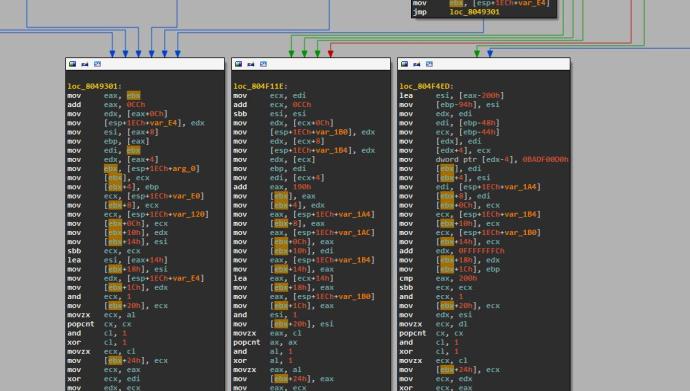
NOTE : If anybody found any better solution or any method to de-obfuscate it using code, please tell me 🙂 I did all of it manually.
NOTE: I haven’t been able to confirm the key as nobody is replying on #csaw irc channel. but I am getting “You win!” as output 🙂
UPDATE 1 : I confirmed with admin. Flag i got is correct 🙂
Thanks to Artem for this amazing problem. I don’t think i solved it by the way he was expecting 😦 but still I got the flag 😛
5. Flag
Flag I got is:
flag{1_ea6lm6aba0faad77703151f6666667}

